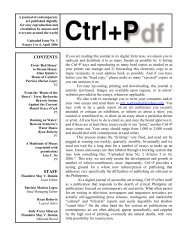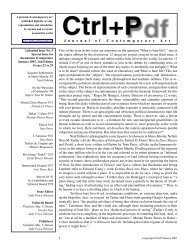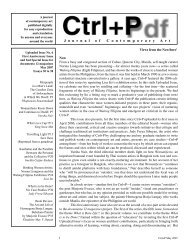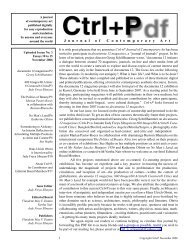Issue 15 - Pdf Ctrl+P - CTRL+P: a journal of contemporary art
Issue 15 - Pdf Ctrl+P - CTRL+P: a journal of contemporary art
Issue 15 - Pdf Ctrl+P - CTRL+P: a journal of contemporary art
You also want an ePaper? Increase the reach of your titles
YUMPU automatically turns print PDFs into web optimized ePapers that Google loves.
<strong>of</strong> the person. In the modern version, everything the person or her personality touches is<br />
provided as “admiration subjects.” The subjects cover everything she touches, as if she<br />
consecrates whatever is around her. This is like a new personality, a kind <strong>of</strong> “hyper-personality.”<br />
The new narcissistic person is not satisfied by her own admiration and desiring<br />
to be admired by the millions. You see this same mechanism with all pop-stars. In this<br />
worship <strong>of</strong> narcissism the sacrifice is “<strong>art</strong>” on the altar <strong>of</strong> spectacle.<br />
Vulnerable Points<br />
There are several vulnerable points in Tracey Emin’s work. Maybe one <strong>of</strong> the most<br />
stigmatic one is that, in spite <strong>of</strong> all the everyday image, carelessness, randomness or<br />
openness, her works are treated in the same way, as more conventional <strong>art</strong> pieces. We<br />
have seen that two times: first, in the fire <strong>of</strong> warehouse; second, in the intervention <strong>of</strong><br />
two Chinese <strong>art</strong>ists. However there is a virtue, <strong>of</strong> which we find plenty <strong>of</strong> samples in<br />
other <strong>contemporary</strong> <strong>art</strong>ists, although missing a little with Emin: temporary character <strong>of</strong><br />
the work. Many <strong>contemporary</strong> <strong>art</strong>ists are creating their works that destroy themselves or<br />
turn into something else with the p<strong>art</strong>icipation <strong>of</strong> other people. However, if it were not<br />
burned in the fire, The Tent would remain the same forever. Maybe an <strong>art</strong>istic instinct<br />
prevented her to do it second time and in this way it has become more meaningful. When<br />
we look at to the case <strong>of</strong> Yuan Chai and Jian Jun Xi, behind a humorous curtain we can<br />
realize a more sophisticated and political theme, which is like a divine punishment to<br />
the intentionally apolitical character <strong>of</strong> Emin’s <strong>art</strong>. After their “p<strong>art</strong>icipation” the work<br />
(My Bed) was restored immediately, then nobody could say that: “this is a living <strong>art</strong> work<br />
and we consider this contribution as a new level <strong>of</strong> the concept.” Let us remember the<br />
motto: “With myself, always myself, never forgetting.” Apparently, a person who says<br />
this would not agree to collaborate with the others.<br />
What was the “contribution” or “intervention” <strong>of</strong> the Chinese <strong>art</strong>ists to Tracey<br />
Emin’s Bed? Yuan Chai and Jian Jun Xi jumped over the My Bed in the Tate Gallery, in<br />
25 October 1999, this is the essence <strong>of</strong> their action, or with their own expression the <strong>art</strong><br />
performance titled Two Naked Men Jump into Tracey’s Bed. The visitors were shocked<br />
during this action, and some <strong>of</strong> them even supposed that this is an <strong>of</strong>ficial p<strong>art</strong> <strong>of</strong> the<br />
event. The Chinese men intended to have some “critical sex” over the bed <strong>of</strong> Tracey Emin<br />
to complete the work, but they could not complete their performance entirely. Yuan Chai<br />
stated that Emin’s work was a strong one, although handicapped by being “institutionalized.”<br />
He said: “We want to push the idea further. Our action will make the public think<br />
about what is good <strong>art</strong> or bad <strong>art</strong>. We didn’t have time to do a proper performance. I<br />
thought I should touch the bed and smell the bed.” There were some words on his body<br />
such as “Communism,” “Freedom,” “Idealism,” and “Internationalism” written in Chinese<br />
and English. J. J. Xi said that Emin’s work was not interesting enough and they wanted<br />
to explore further, making it more significant and sensational. The words on his body<br />
were “Optimism,” “Idealism” and “Anarchism.” The gallery covered up this action and<br />
neither the gallery nor the <strong>art</strong>ist made another attempt to charge the Chinese <strong>art</strong>ists.<br />
So, there were two more names in Everyone T. Emin Slept With. Yuan Chai and<br />
Jian Jun Xi, not at the same time, but at the same bed, took their place with a serious<br />
intention to practice on/with her bed. So, why not include their names as well in a possible<br />
reincarnation <strong>of</strong> The Tent? Neither the gallery nor the <strong>art</strong>ist was willing to accept<br />
this p<strong>art</strong>icipation. The reason was intuitively expressed by Yuan Chai: institutionalization.<br />
The institutionalization process, despite the opposite image, has continued as a<br />
vulnerable point. In fact, it would be fairer to change the title <strong>of</strong> the work to Our Bed, as<br />
it belonged to the Chinese <strong>art</strong>ists as well. However, the more the narcissistic character<br />
spread through, the stronger she would react to any other dissolution in the water <strong>of</strong> her<br />
self-centered <strong>art</strong>istic production. Hence, the gallery just restored the installation, ignoring<br />
the new contribution.<br />
30 <strong>Ctrl+P</strong> September 2009







